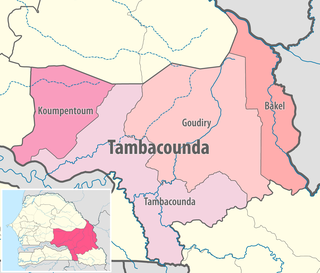
Bakel Department is one of the 45 departments of Senegal and one of the four making up the Tambacounda Region in the east of the country. The department had an area of 22,378 km² and population estimate at 215,680 in 2005. However, in 2008 the department was split to form the new department of Goudiry, so the area was reduced to estimated 6,290 km².
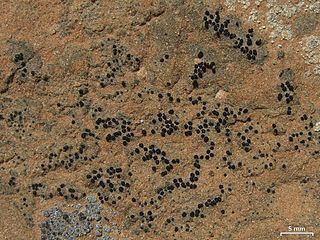
Staurothele is a genus of saxicolous (rock-dwelling), crustose lichens in the family Verrucariaceae. It has about 40 species. When the fungus is part of a lichen, the genus of lichen is commonly called rock pimples.
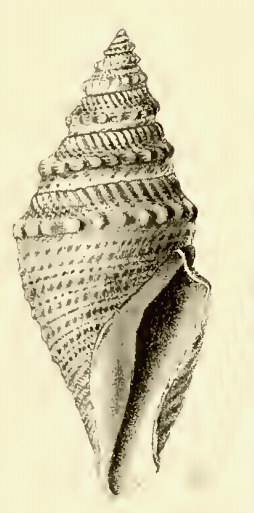
Bathytoma fissa is a species of sea snail, a marine gastropod mollusk in the family Borsoniidae.
Megalorhipida fissa is a moth of the family Pterophoridae that is known from Yemen.
Lichens of the Sierra Nevada have been little studied. A lichen is a composite organism consisting of a fungus and a photosynthetic partner growing together in a symbiotic relationship.
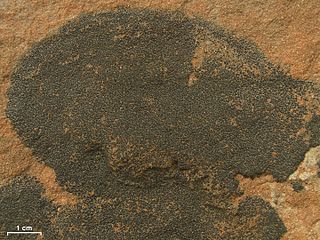
Staurothele areolata is blackish-brown crustose lichen in the family Verrucariaceae. It is found in western North America.

The 2015 Campania regional election took place on 31 May 2015. The centre-left coalition candidate Vincenzo De Luca defeated the incumbent president, Stefano Caldoro of Forza Italia within the centre-right coalition, and became the new president of Campania. Until the 2024 Sardinian regional election, this was the last regional gain for the centre-left coalition.
Urtica fissa is an upright perennial herb native to streams and rainforest of China.

An indirect presidential election were held in Greece on Wednesday 22 January 2020 for the President of the Hellenic Republic. Incumbent President Prokopis Pavlopoulos, who was elected by the Hellenic Parliament on 18 February 2015, was eligible for re-election but was not suggested by the government.
Elaphromyia fissa is a species of tephritid or fruit flies in the genus Elaphromyia of the family Tephritidae.
Heteroplacidium zamenhofianum is a species of lichenicolous (lichen-eating) lichen in the family Verrucariaceae. As a juvenile, it is parasitic on some members of the lichen genus Staurothele, but later becomes independent and develops a brown, crustose thallus. Characteristic features of the lichen include its dark brown, somewhat squamulous thallus and relatively small ascospores. It is widely distributed in Europe and North America.
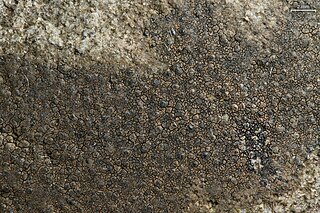
Willeya is a genus of saxicolous (rock-dwelling), crustose lichens in the family Verrucariaceae. It has 12 species. Most species are found in southeast Asia, although individual representatives are known from Australia, Europe, and North America.
Willeya australis is a species of saxicolous (rock-dwelling), crustose lichen in the family Verrucariaceae. Found in Indonesia, it was formally described as a new species in 1954 by Dutch lichenologist Pieter Groenhart, as Staurothele australis. He found the type specimen growing on rocks in the falls of the Brantas River. Although he included it in the genus Staurothele, he suggested that a placement in Willeya might also be appropriate. Cécile Gueidan made that generic transfer official in 2014 following molecular phylogenetic analysis of Staurothele and related genera in the Verrucariaceae.

Staurothele elenkinii is a species of saxicolous (rock-dwelling) lichen in the family Verrucariaceae. It was described as new to science by Ukrainian lichenologist Alfred Oxner in 1927, from the steppes of Ukraine. In 2013 it was recorded from the northeast Caucasus, in Russia. It is also widespread on dry rocks in the North American west, ranging from the Northwest Territories south to the southwestern United States. It grows on shales, sandstones, and calcareous rocks.
Staurothele nemorum is a species of saxicolous (rock-dwelling) lichen in the family Verrucariaceae. Found in the United States, it was formally described as a new species in 2019 by Caleb Morse and Douglas Ladd. The type specimen was collected from the University of Kansas Ecological Reserves, in Baldwin City (Kansas). The species epithet nemorum, which combines the Latin roots nemus and -oris, alludes to the habitat of this lichen. It occurs in the southern Great Plains in central North America, and has been collected in the states of Kansas, Missouri, Oklahoma, and Texas. It prefers dry sites, often on south- and west-facing exposures, where it grows on pebbles and cobbles of limestone and calcareous sandstone.

Staurothele pulvinata is a species of saxicolous (rock-dwelling), squamulose lichen in the family Verrucariaceae. The lichen was first formally described in 1861 by Theodor Magnus Fries, as a member of genus Endocarpon. The type specimen was collected from northern Norway. The taxon was later transferred to Dermatocarpon by Gustav Wilhelm Körber in 1863, and to Polyblastia by Antonio Jatta in 1900. Starri Heiðmarsson moved it to Staurothele in 2017, based on molecular phylogenetic analysis that showed it belonged to that genus. It is one of few squamulose species in a genus comprising mostly crustose lichens. Staurothele pulvinata has an arctic-alpine distribution; it has been recorded from Europe, Greenland, Iceland, and the United States.

Drymocallis fissa, the bigflower cinquefoil, also known as the leafy cinquefoil, leafy drymocallis, or wood beauty, is a small plant also sometimes classified as Potentilla fissa. It is a herbaceous plant with a thick taproot known for its moderately hairy leaves, redish leaf stems, and relatively large yellow flowers. It is native to foothills and lower mountains the Rocky Mountain region in the western United States.

Staurothele drummondii is a species of saxicolous (rock-dwelling) crustose lichen in the family Verrucariaceae. It is widespread in northern North America, but has also been recorded in Eurasia, Greenland, and Iran.










